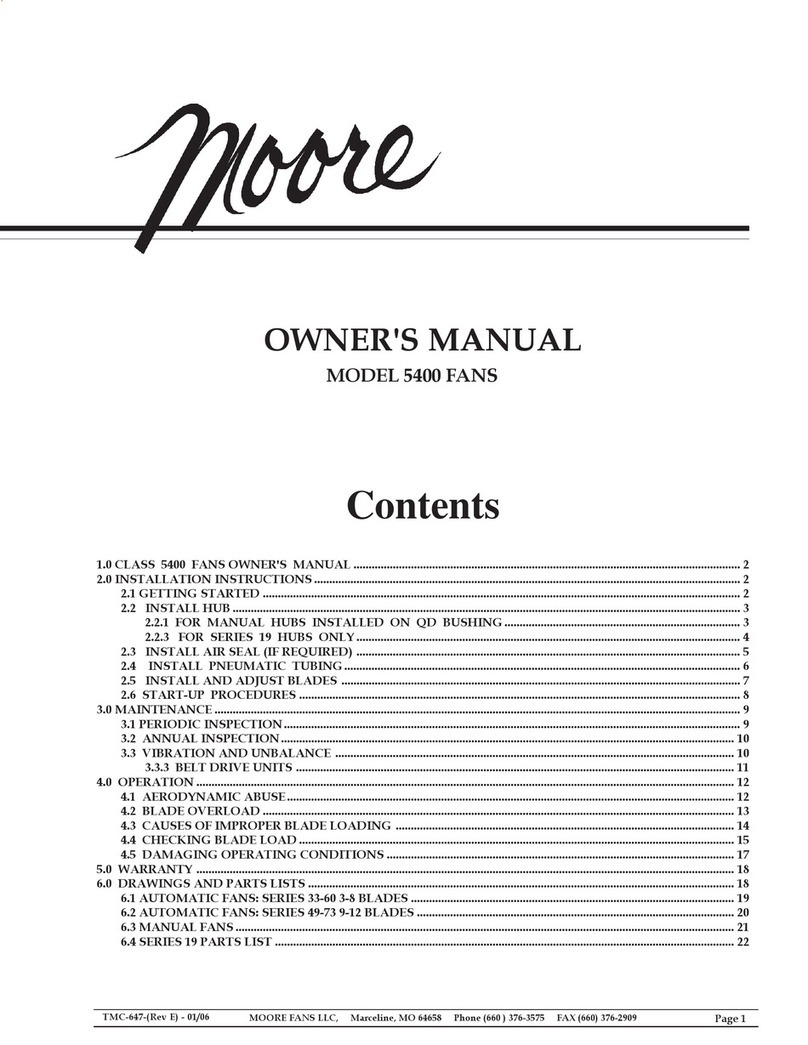
Page 6 TMC-672-(Rev E) - 05/02
MOORE FANS LLC, Marceline, MO 64658 Phone (660 ) 376-3575 FAX (660) 376-2909
3.0 MAINTENANCE
3.1.1 PURPOSE
Fan failure is most likely the result of destructive repeti-
tivestressactingoveraperiodof time. These stresses may be
caused by mechanical abuse, e.g. rough gears or drive shaft
imbalance, or by aerodynamic abuse such as blade overload
or abnormal flow conditions. Fortunately, these stresses
manifest themselves in typical ways that may easily be
detected on inspection if one knows what to look for. The
purpose of this section of this manual is to describe the
symptoms of potentially damaging mechanical problems
and how they can be corrected. Aerodynamic abuses are
covered in Section 4.0 Operation.
3.1.2 FREQUENCY OF INSPECTION
The frequency of inspection varies widely in accor-
dance with the severity of service and a suitable inspection
schedule should be developed with experience over time.
During the first week of operation, at least one inspection
should be made. At these initial inspections, in addition to
the items listed below, check all nuts for tightness to make
certain that all were tightened properly at installation (but
do not re-torque already tightened nuts). Following the first
week, it is probable that inspections of the fan need be made
no more frequently than inspection of the drive.
3.1.3 CHECK BLADE ANGLE AND RUNNING POSI-
TION
Turn off the unit and watch the blade tips. A looseness
in the hub tube will permit a blade to flatten in angle. This
usually can be detected by looking at the tips of the blades
while the fan is slowing down. At the same time, before the
unit comes to a complete stop, watch the track of the blade
tips to see that all blades have the same droop. If one or more
blades have a substantially different droop than the other
blades, or if all of the blades show a greater droop than at the
last inspection, investigate further. Excessive droop has two
possible causes:
1. A damaged resilient mount that requires replace-
ment.
2. Wear at the end of the box section against the clevis,
indicating that the box section has been riding against the
clevis during operation. This type of wear indicates that the
blade is not rising during operation a sufficient distance to
clear the stop. If only one blade is affected, that blade is set
at a steeper angle than the other blades. This should be
checked and corrected.
3.1.4 CHECK FOR WEAR ON CLEVISES
Clevises should be examined at each inspection for
possible wear against the end of the box section. Since
contact between the box section and the face of the clevis
provides a stop to prevent excessive droop when the fan is
shut down, there will undoubtedly be a mark on the face of
the clevis at the point of contact. There should, however, be
no evidence of wear which would indicate repetitive contact
between the two parts during operation. If wear at this point
is indicated, a check should be made of blade loading as set
out under Section 4.4 Checking Blade Load. If blade over-
load is not responsible, the end of the box section can be
dressed off with a file to permit greater blade droop when
the fan is not operating so long as the greater droop will not
cause the blade to hit an obstruction. If the fan has been
operating for a considerable length of time and previous
inspections have not disclosed wear at this point, it is
possible that a recent unusually high wind condition might
have disturbed the blades sufficiently to cause them to
temporarily make repetitive contact with the clevis while in
operation.
3.1.5 CRACKS, DENTS AND CORROSION
Skincrackingmaybecausedby the tips dragging onthe
fan ring, or it may be the result of long-term fatigue due to
continued operation under conditions of vibration or unbal-
ance as discussed in Section 3.3 which follows. Skin cracking
can also be caused by continued operation under overload
conditions as discussed in Section 4.3 Causes of Blade Over-
load.
Cracking in air seals can occur if the airseal has been
improperly installed. See Section 2.2. Check to be sure the
resilient washers are present and the nuts properly tight-
ened.
Thefatiguestrengthof materials,whethermetalor plastic,
may be lowered by long-term exposure to water.
Dents in blades are caused by objects falling into the fan
or the fan striking some obstacle. Minor dents may some-
times be repaired by drilling a small hole in the center of the
dent and pulling outward on the blade skin. Blades may be
ordered from the factory for replacement. If there is any
evidence of this type of damage, the hub should be carefully
inspected as discussed in Section 3. 1.6 which follows.
The Type 5052 aluminum, a marine alloy, used as the
blade material on Moore fans works well with either fresh or
sea water. Waters that are acid, alkaline, or contain copper
salts, however, should be avoided for all aluminum alloys.
If you have questions regarding the suitability of the fan
materials under certain water conditions, please contact the
factory.
3.1 PERIODIC INSPECTION
3.1.6 HUB INSPECTION
If damage to the fan has occurred, the hub should be
carefully inspected since subtle damage may have been
caused that is not readily apparent. Check the hub for any
sign of bending or twisting of the hub tubes. Hub tubes
cannot be replaced in the field on manual fans and a new
hub should be ordered.
Bushings are frequently cracked during a fan wreck
andshouldbe carefullyinspected.Damage mayoccurto the
stainless steel studs that attach the hub to the bushing. It is
a good idea to replace the studs when replacing a damaged
fan blade
MAINTENANCE




























